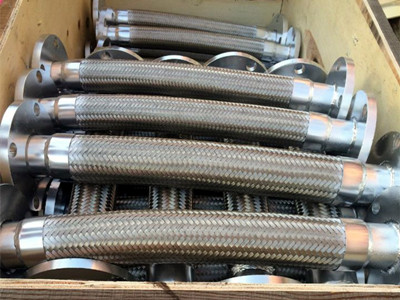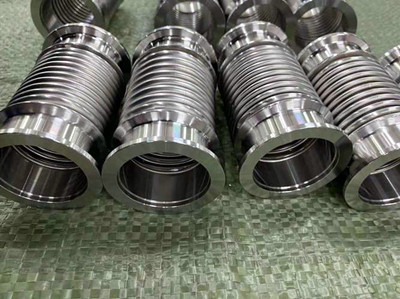Many people will confuse metal flexible joints, corrugated metal hoses, metal hoses, pipe compensators, and corrugated expansion joints, thinking they are a class of things. However, they are still very different. Metal hose and compensator is a general term for two types of products; metal hose contains metal bellows, flexible metal joints, and so on, while the compensator contains expansion joints, non-metallic compensators, and so on. This article tells the difference between a metal hose and a compensator.
What is a metal hose?
Metal hose is composed of stainless steel mesh body, stainless steel bellows, and different types of fittings; there are two kinds of body, one is spiral corrugated, and one is composed of circular corrugated; the body is usually added to the external layer of woven wire mesh, generally stainless steel wire by certain parameters from the textile. Although the metal bellows are flexible and good, it does not have fatigue resistance, high and low temperature resistance, or corrosion resistance as expansion joints, and they also do not have a long service life as compensators. With the rapid development of the national economy, high and low temperature, high pressure, and corrosion-resistant corrugated metal compensator gradually replaced the role of metal hose, which is widely used in various pipeline construction.

Wall of metal hose
Different metal materials form the pipe wall of a metal hose through a special manufacturing process. The thickness of the wall and the choice of material will directly affect the performance and service life of the metal hose. Commonly used materials include stainless steel, copper, aluminum, etc.
The interface of the metal hose
The interface is the part of the metal hose that connects to other equipment or pipes. The design of interface and material selection is also an important part of metal hose design. According to the need, the interface can be designed as a threaded connection, flange connection, welded connection, etc.
Sealing part of metal hose
The sealing part is key to ensuring that the metal hose will not leak in the working process. The material of the sealing part needs to be selected to withstand the pressure, temperature, and medium in the working environment of the metal hose.
Characteristics of metal hose
The metal hose has the following significant characteristics:
Good softness and high pressure resistance
The softness of metal hoses enables them to be used in various complex working environments, including in limited spaces and where they need to be bent or swiveled. At the same time, due to its high pressure-bearing capacity, metal hoses can work in high-pressure environments.
Excellent corrosion resistance
The choice of materials and design of metal hoses gives them excellent corrosion resistance, enabling them to be used in various chemical media.
Long service life
The high strength, abrasion resistance, and aging resistance of metal hoses give it a long service life.
Easy installation and maintenance
The design of the metal hose makes it easy to install and maintain. Once a problem occurs, you only need to replace the damaged part without replacing the whole hose.
Above is our basic introduction to metal hose; metal hose plays an important role in our life, so it is necessary to have a basic understanding of it. We hope this article is helpful to you.
What is a compensator?
Customarily also called expansion joints, etc. also consists of different parts of the composition of the main body of its work, the bellows (an elastic element), plus the end of the tube, brackets, flanges, conduits, and other accessories, belonging to a compensatory element. The principle is to use the effective expansion and deformation of the main body of the bellows to absorb pipelines, containers, etc., by thermal expansion and contraction and other reasons for dimensional changes or to compensate for pipelines, containers, etc., axial, lateral and angular displacements but also can be used for noise and vibration reduction. His performance is characterized by high and low temperature resistance, high-pressure resistance, corrosion resistance, and long service life.
The non-metallic compensator is also called the non-metallic expansion joint, duct fabric compensator, non-metallic fabric compensator, etc. It is widely used in iron and steel smelting, the petrochemical industry, thermal power generation, cement plant, and atomic power plants. It can be used at the entrance and exit of smoke desulfurization, dust removal, air heating, and other equipment. It can compensate for multiple displacement directions, with various forms, large compensation volume, long service life to effectively compensate for or eliminate the installation error, and at the same time, low stiffness, low elasticity stress, high range of applicable temperatures, good corrosion resistance, and effective isolation of vibration and noise reduction. Its performance is better than the metal expansion joints, so that users will receive it, and it has been vigorously promoted. Working pressure is low in the ventilation; dust exhaust, air conditioning pipe insulation, and other places are often used.

Where is the difference between a stainless steel metal hose and a corrugated compensator?
Stainless steel metal hose is used for mechanical equipment pipeline connection, and the bellows compensator is made of stainless steel and looks similar to the wave pattern; the name can also be called compensator; the two materials are the same as 304 stainless steel plate or 316 stainless steel plate two types, the application of metal materials hose temperature range within 300 degrees of 304 stainless steel plate is highly recommended, 400 ° C Within the highly recommended 316 materials; they are more differences, the following will be for everyone from several levels to analyze the stainless steel metal hose and metal material bellows compensator in the middle of the different.
- 1. Appearance difference. Metal hose made of stainless steel metal hose or steel chain hand-woven outer net address made of plastic hose, with excellent softness, a few sections with connectors; can solve the small hot and cold deformation and tube body vibration, then the general plastic hose life and reliability have been greatly improved, if the customer stipulates higher can be upgraded to double braided; metal material bellows compensator net specifications are very large, applicable to compensate for the large and medium-sized pipeline Offset, in the high temperature or ultra-low temperature caused by the thermal expansion and contraction of the deformation of the metal hose to carry out compensation for the offset, to ensure that all the normal operation of the pipeline, the length is generally shorter than the stainless steel plate metal hose.
- 2. Connection difference. In stainless steel metal hose, according to the connector connection, there are flange connectors, clamp connectors, and threaded connectors; the type can also weld random connectors, so the connection is colorful, and the metal compensator is limited to the scope of application, in general, can only be two: flange connection and take over the connection.
- 3. Stainless steel metal hose manufacturing is very simple; the key, according to the length of the requirements for manufacturing laser cutting, can be. Bellow compensator manufacturing is more complicated and must be based on the amount of compensation and bearing capacity to specify the metal hose wall thickness and then carry out manufacturing.
How to choose the right metal hose and metal compensator?
Choosing the right metal hose and metal compensator can play a vital role in the safety and reliability of a system. The effective operation of metal hoses and metal compensators can only be ensured by understanding the working conditions, choosing the right material and type, correct installation, and regular maintenance. At the same time, finding a reliable supplier and obtaining professional technical support are important to ensure the system’s smooth operation.
Understand the working conditions.
The first step in selecting metal hoses and metal compensators is to understand the environment in which they will operate. For example, operating temperatures, pressures, chemical environments, and vibration frequencies are all factors that must be considered. An in-depth understanding of the working conditions not only helps us to choose the most suitable products but also effectively avoids system failures caused by improper selection.
Choosing the right material and model
The material and model of metal hose and metal compensator directly impact their performance and life. For example, 304 stainless steel hose is suitable for most low and medium-pressure environments, while 316L stainless steel is more suitable for high-pressure and highly corrosive environments. The choice of model depends on the specific needs of the system, such as connection type, length, diameter, etc.
Correct installation and regular maintenance
Correct installation methods and regular maintenance checks are the key to ensuring the normal operation of metal hoses and metal compensators. Excessive bending or twisting of the hose should be avoided during installation to avoid excessive stress. Regular maintenance inspections can detect potential problems, such as metal fatigue, corrosion, leakage, etc., in time to avoid failures.
Find a reliable supplier and get professional technical support
Finding a supplier who provides high-quality products and professional technical support is an important step to ensure the safe and reliable operation of the system. Only a professional supplier can provide high-quality products, in-depth knowledge of product performance, effective solutions, and timely technical support when needed.
Choosing the right metal hose and metal compensator is critical to the safety and reliability of the system. By understanding the working conditions, choosing the right material and type, correct installation, and regular maintenance, we can effectively operate metal hoses and metal compensators. Finding a reliable supplier and obtaining professional technical support is also important to ensure the stable operation of our systems.
Frequently Asked Questions
Question 1: What is the life span of a metal hose and metal compensator?
The lifespan of metal hoses and metal compensators depends on operating conditions, usage environment, and maintenance. Generally, they are designed to last for years to decades.
Question 2: What are the common failures of metal hoses and metal compensators?
Common failures of metal hoses and metal compensators include leaks, fatigue fractures, and loose connections. These failures are often related to improper conditions of use, poor maintenance, or material quality.
Question 3: What industries are metal hoses and metal compensators used in?
Metal hoses and metal compensators are widely used in chemical, petroleum, electric power, pharmaceutical, food processing, and other industries for conveying liquids, gases, steam, and other media.
Question 4: Can metal compensators replace metal hoses?
Metal compensators and metal hoses are different in function. Metal compensators are mainly used to compensate for thermal expansion and mechanical deformation of pipelines, while metal hoses are mainly used for pipeline connection and bending. Therefore, they may be complementary in different application scenarios.








